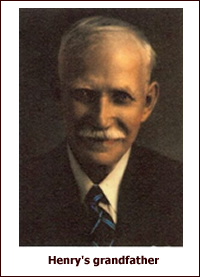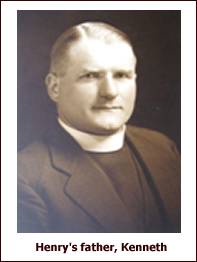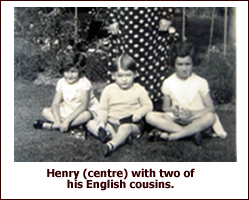My dad’s cousin is also my godfather and he was 75 this year. I’ll call him Henry.
Henry loves to talk and is a mine of information. However, he has the sometimes disconcerting habit of chatting away and jumping about in the conversation between various members of the extended family and just assuming that you know who he’s talking about! I’m sure we all have relatives that do that, but with Henry’s slight deafness added to that, it’s sometimes difficult to follow his reminiscences.

I’ve been doing a bit of untangling over the last couple of years, since I started on my own family history research, and it’s getting more interesting by the day. I’d like to tell you about Henry’s family and the amazing thing that happened on 29th August 2007.
We need to wind back the clock a bit and look at a bit of history – Henry’s grandfather.
At the turn of the century (19th to the 20th), Henry’s grandfather worked at a sawmill in Norway, cutting wood in the winter and huge blocks of ice to be packed in sawdust and sent south during the summer. With the advent of mechanical refrigeration many workers were laid off and this led to huge unemployment problems. Henry’s grandfather already had many mouths to feed at home.
In the latter part of the 19th century the USA desperately needed farmers used to extreme conditions to show their farmers how to farm the far north of the country where it was very cold. The Homestead Act of 1862 opened up land to settlers who promised to farm and live on the land for five years. Other government actions, such as treaties with Minnesota Indians, opened up even more land for white settlement. Land in the United States was quite cheap. In Minnesota, land costs were as low as $1.25 per acre by the mid to late 1800s, when bought from the government, as opposed to $5-$10 when purchased privately.
As well as the advantage of the price of land, wages were much higher in the US. Henry’s grandfather could hope to earn $40 to $50 a year at home in Norway, but a craftsperson in an American city could earn as much as $4 to $5 a day. Jobs in Norway had become hard to find with more and more manual labour being replaced by machines. Many of the early US settlers were farming families and it is not surprising that the promise of finding land and jobs with better pay led many Norwegians to emigrate to the USA and on to Minnesota.
Henry’s grandfather left Christiania (now Oslo) in August 1907 aboard the ‘Karonia’ with his two eldest children, one of whom was Henry’s mother aged about 16. They arrived in New York 25 days later. Once they had settled they sent for the rest of the family; Henry’s grandmother and five more children. Life was hard and as soon as she could, Henry’s mother, Amanda, left home (as the eldest, she’d been a general dogsbody to all those children). Henry remembers that his mum could do anything; split wood, milk cows and carry great weights as well as the more traditional ‘women’s work’ in the house. Her escape was to go over the border to Canada to nurse in a Salvation Army Hospital.

Henry’s father, Kenneth, was the third of six children. He was from Norfolk and had survived the Western Front in 1918. He went to Canada to attend Emmanuel College, Saskatoon, Saskatchewan to take a theological degree. However, he had difficulty making ends meet and left the college to join the Salvation Army with whom he evangelised in the prairies (mostly Manitoba).
Kenneth broke his leg in a winter sports accident and was taken to the Winnipeg Salvation Army Hospital where, you’ve guessed it, he met Amanda.
They married in 1927 and suffered the grief of 3 stillborn sons before Henry’s birth in 1932. In 1933 the new family moved to England where Kenneth was ordained a priest in Liverpool Cathedral. Everything was going well and Kenneth’s youngest brother (my grandfather) asked him to come down to Norfolk to perform his wedding ceremony. Kenneth, Amanda and little Henry came to Norwich in preparation. A few days before the wedding Kenneth was tragically killed in a motor accident, he was 34.
Amanda remained in the UK, a few of her (US Norwegian) siblings came to visit from time to time and she eventually remarried.
In the early 1970’s she got knocked down by a car outside her flat in Essex, while her sister was staying with her and, although she was nursed back to physical health, she ‘lost her mind’ and died 3 years later.
My godfather, Henry, knows a lot of the family history from England because he spent a good deal of time with cousins, aunts and uncles, who all pulled together to help while his mum was alone. He also travelled quite a lot because many members of his father’s family had gone abroad; to the Ukraine, to New Zealand, to Australia as well as to Canada. He didn’t visit all of these places but he had cousins everywhere with whom he exchanged letters. He has given me much more information about all these than my own father who had less contact with them all. This information includes a horrific story about an uncle that took out his glass eye in front of the young cousins and gave them all nightmares for months!
Henry married in 1955 and had 4 children. His beloved wife died in 2005.
I used not to see Henry much because, firstly, I lived in Devon and the road to the small Suffolk village where he lived wasn’t good and it took forever to get there and, secondly, because I’ve been living abroad for the last 20 years or so.
In the last few years I have managed to go to see him for a few days each summer with my own children. He loves travelling and came to my wedding in France in 1998 and in February last year he went out to New Zealand for an antipodean family reunion – he was the only European there. He told me that he had wanted to go to the US to catch up with his Norwegian cousins a few years ago, but had heard that most of them had already passed away.

So, now that you know about Henry and his family, I can tell you about the email, from one of the 40 (!) visitors to my Tribal Pages site. It arrived on 29th August 2007. An American named David, originally from Minnesota now living in Texas, had idly tapped Amanda’s family name into a search engine and my page popped up. David’s grandmother was Henry’s US/Norwegian aunt, the one that was staying with Amanda when she got knocked down by the car.
In fact, David and I are both related to Henry in the same way – I’m Kenneth’s brother’s grand-daughter and David is Amanda’s sister’s grand-son.
After a couple of emails between David and I, and a quick call to Henry telling him about the new contact and working out how he was related, Henry asked me to send his phone number and address to David because Henry is no good with email.
I thought no more of it really because usually, in my limited experience, these things always take time but later that same evening David telephoned! He had already called Henry and chatted for about half an hour. He knows a lot about the Norwegian side of Henry’s family and I’m really excited at being able to ‘give back’ a little for all the valuable information that Henry has shared with me.
In fact Henry has decided on a trip to Minnesota to visit his new found relatives, as well as a visit to his birthplace of Edmonton, Canada, for the first time since he left. His trip is planned for the summer of 2008.
Everyone is happy, as we’re all busy ferreting out all the information we have on this Norwegian part of the family so that we can pool it all together.
I have only just discovered why Kenneth went to Canada in the first place, there were surely similar degrees on offer in the UK – it was because of his itchy feet!
Lozaras
© Lozaras 2007
